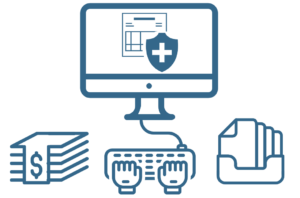Becoming a Medical Transcriptionist
MT, or Medical Transcription, is a particular allied health career handling the processing and transcribing of medical reports that are voice-recorded being dictated by doctors, nursing staff and other medical professionals.
Clinical records may be audio recordings, lecture notes, or some other discussed content. These records are dictated through phones or published through the Internet or by using smartphone applications.
Becoming a certified medical transcriptionist by earning your RHDS or CHDS will open the door to many career opportunities in many different settings including working in your own business or even from home.
There are a number of paths to getting your medical transcriptionist certification that we will cover on this page.
First let’s go over what a medical transcriptionist is, what they do, where they work and how much medical transcriptionists earn.
Responsibilities: Physicians make dictated recordings that medical transcriptionists create reports and other administrative documents from. Apart from transcribing, medical transcriptionists are also editors fixing grammatical mistakes and ensuring proper usage of medical terminology in the patient records. Becoming an expert in medical terminology, medical procedures, anatomy, and pharmacology will be required. You also must be familiar with the ethical and legal standards that relate to health records and have a strong attention to detail.
Work Settings: Public health agencies, nursing homes, home health care agencies, physicians’ clinics, general clinics, hospitals and more. It is also common for medical transcriptionists to work as independent contractors, or as employees of transcription companies. You can also find work from home opportunities for medical transcriptionists.
Degree Requirement: Certificate, diploma or associate’s degree
Annual salary (median): $35,250
Training and Education
As a prerequisite to a certified medical transcription training program, you will need a high school diploma or GED. Medical transcription programs usually last 6 months to 2 years and can result in certificate, diploma, or an associate’s degree.
Students must learn medical terminology with a firm understanding of definitions, grammatical usage, spelling, and pronunciation. Before graduating you will need to gain hands on medical transcription experience.
Medical transcription courses consist of the following:
- English grammar and composition
- Computer programs
Medical vocabulary/terminology - Pathology
- Physiology and anatomy
- Medical transcription skills
An Associate of Medical Transcription is most often earned at a vocational school or community college.
You can also find online medical transcriptionist programs and online medical billing courses.
Medical Transcriptionist Certification
Certification is not required but it comes highly recommended for good reasons. Passing the national exam provided by the Association for Healthcare Documentation Integrity (AHDI) gets medical transcriptionists the credential of Certified Medical Transcriptionist (CMT). Continuing education is required to maintain your certification, credits must be earned every 3 years.
There are two primary industry certifications for medical transcriptionists:
- Registered Healthcare Documentation Specialist (RHDS)
- Certified Healthcare Documentation Specialist (CHDS)
The RDHS is for recent grads of medical transcription programs with less than 2 years of working experience
The CHDS is for professionals with over 2 years experience in a multi-specialty practice or acute care.
The RDHS used to be the Registered Medical Transcriptionist (RMT) and the CHDS used to be the Certified Medical Transcriptionist (CMT).
Medical Transcriptionist Specialties
Once you are a certified medical transcriptionist you will have a variety of areas where you can specialize.
Here is a list of medical transcriptionist specialties:
- Podiatry
- Pediatrics
- Orthopedics
- Plastic Surgery
- Urology
- Allergy
- Internal Medicine
- Psychiatric
- Family Medicine
- Dermatology
- And many more
Sources:
U.S. Bureau of Labor Statistics 2018-19 Occupational Outlook Handbook; Medical Transcriptionists. (Link)
Association for Healthcare Documentation Integrity (AHDI)

